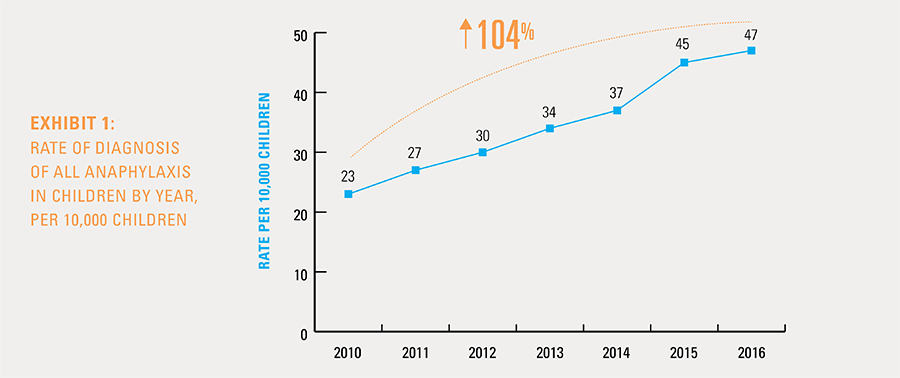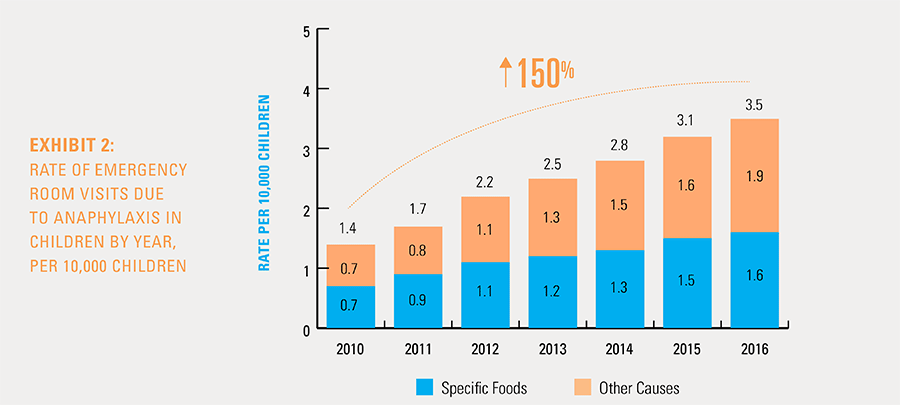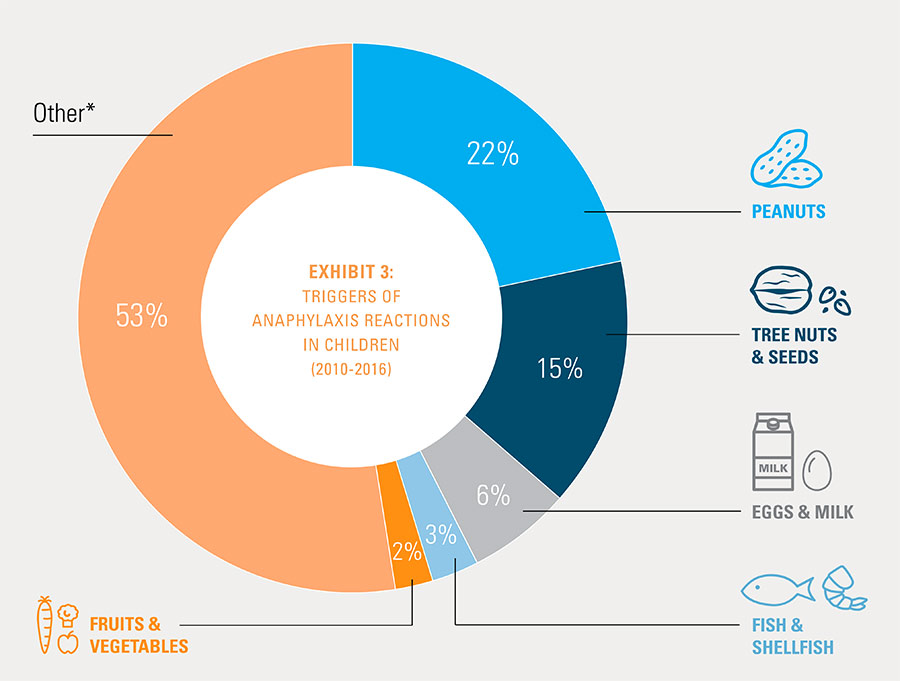Blue Cross Blue Shield (BCBS), the federation of insurance organizations insuring more than 106 million Americans, issued a report on childhood allergies based on their records of 9.6 million commercially insured children 18 years and younger between 2010 and 2015.
Nearly 1.7 million children (18%) suffer from some sort of allergy, ranging from mild seasonal allergies to severe food allergies. The report focused specifically on the incidence of anaphylaxis.
Specific findings quoted from the study summary:
- Children diagnosed as “at risk” for an anaphylaxis episode increased 104% during the study period, rising from 23 per 10,000 children in 2010 to 47 per 10,000 children in 2016. The corresponding rate of emergency room visits due to anaphylaxis reactions increased by 150%, from 1.4 visits per 10,000 children to 3.5 visits per 10,000 children. While these children represent a small portion of all commercially insured children, diagnosis rates continue to increase.


- Allergic reactions to specific foods are responsible for nearly half (47%) of anaphylaxis episodes. The most common foods that trigger allergic reactions are peanuts (22%), tree nuts and seeds (15%), and milk and eggs (6%). However, 53% of these allergic reactions are due to unknown foods or other unspecified causes (such as insect bites), which highlights the need for parents of at-risk children to be prepared for a reaction at any time.
- Approximately 18% of children suffered from any type of allergy in 2016, increasing slightly from 17% in 2010. Two of the most common allergies found in these children are rhinitis (affecting 9% of children) and dermatitis (affecting 5% of children). Rhinitis shows yearly peaks that correspond with plant and dust allergy seasons in the spring and fall, while dermatitis remains relatively stable over the study period.
- Diagnosis of any type of allergy decreases as all children get older, as 25% of all children ages 0 to 2 are diagnosed with one or more allergy compared to only 14% of children ages 14 through 18 in 2016. Allergy rates drop considerably more for boys as they grow older than for girls. Boys under the age of 3 have the highest rate of diagnosis of any age group at 26%, while boys ages 14 through 18 have the lowest rates of allergy diagnosis of any age group at 13%.
Epinephrine Auto-Injectors
The average cost of a two-pack of Mylan’s EpiPen rose sharply from $129 in 2010 to $645 in 2016 and has since fallen to $493 as competition takes hold in the market. The average price for the Adrenaclick generic has fallen to $234 and has gained market share to 21% of epinephrine auto-injector sales.
Triggers of Anaphylaxis
Reactions to foods was responsible for 47% of allergic incidents with the following distribution: peanuts – 22%, tree nuts and seeds – 15%, milk and eggs – 6%, fish and shellfish – 3%, and fruits and vegetables – 2%.
More than half were attributed to other sources, including insect bites and unidentified sources.

Conclusion
Nearly 1.7 million, or 18 percent, of commercially insured American children suffer from one or more allergy. While a small portion of overall allergies, there has been a substantial increase in the most severe anaphylaxis allergic reactions in children which has largely been triggered by foods. This increase in severe anaphylaxis reactions coincides with a steep rise in ER visits for this condition. Other regularly diagnosed allergies of rhinitis and dermatitis did not change markedly throughout the study period but remain a common complaint of those suffering from allergies. As a whole, the rate of all children diagnosed with one or more type of allergy increased moderately during the study timeframe, with boys more likely to be diagnosed with an allergy than girls.
Continued focus on proper identification and diagnosis of childhood allergies remains an important step to help keep children safe. The availability of and access to epinephrine auto-injector medication and ER costs associated with treating children in emergencies remains a topic of public health discussion. As more children are found to suffer from food allergies and are at risk of life-threatening anaphylactic reactions, the availability of affordable medication and ER care will be critical in safeguarding the health of American children.






